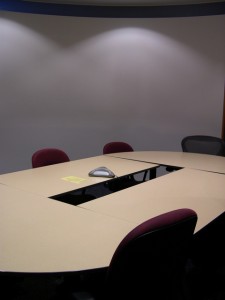How to throw an AMAZING meeting
I’ve been to far more meetings than any one on earth should ever have had to by the time they’re 25. With that experience, however, I can start to pick out key points of running a great meeting or demonstration. I know this is a different type of post for this blog, but I think its important. There may be times that you’re called on to conduct a meeting or demonstration, as a technical resource. Follow these tips and your meeting will go along smooth, efficiently and successfully.
Planning
Have an Outline
Outline the points you’re going to cover. Provide more elaboration on an outline that you refer to as your Internal outline. Examples of this include writing a more thorough document for yourself or using the notes section for your powerpoint presentation (simply print out the slides with notes for yourself, give everyone else the slides only.)
Send your outline out before the event. Gauge the busyness of your audience to figure out when you should send it out. Don’t send it out 10 minutes before the meeting if you have people who are traveling or may be in other meetings. Conversely, don’t send it out too many days in advance - it may get lost in the pile of other things your attendees have to review.
Test Technical Items
You should run through any technical demonstration at least once before you create the presentation. Everyone remembers Bill Gate’s famous BSOD during his demonstration of Windows - and I’m sure that was even a rehearsed demonstration. Try to avoid situations like this by testing your technical aspects ahead of time.
Arrival
Arrive Early
If you are either facilitating the meeting or participating in it, make sure to get there early. We’re not talking hours early - but you should aim to be the first person there. This will help you build confidence in arriving parties: they know you’re there, prepared, in control and ready to present to them. It can be an uncomfortable experience to arrive at a meeting when there is no one else in the room. Attendees might question that they’re in the right room, if they have the right time, etc. This also provides you time to verify that any presentation aides are available.
Intro on Time
Generally, when sending out a meeting invite, there is a concise summary of what the meeting is about. When the meeting is scheduled to begin, begin your introduction. This does two useful things for you: first, it reminds attendees who may be hopping from meeting to meeting what the content of this meeting will be. Second, it sends a message that you are in control of the meeting, and that attendees can trust that you will end the meeting on time - and that their time is not being wasted. Sometimes people take this to an extreme and start the content right at the time. Don’t do this! Sometimes things happen - allow for a little leeway - but make sure that the time counts. Your intro may be 1 to 2 minutes starting exactly at the meeting start time. Enough time for those who are trying to make it in on the wire to attend.
Present
Provide easy ways of feedback
Some attendees may feel too nervous to shout out a question during your presentation. Start out by telling them that you can either stop you with a question or get my attention by waving your hand or directing it at you. You may want to give a demonstration of casually getting someone’s attention. Then, be attentive! Sometimes your best questions will come from people who are too meek to make a huge presentation.
Ask Questions
Along the way, its fine to ask questions - or better yet - encourage questions. Summarize a point and ask if there is any clarification needed on that point. Its useful to remind people that they can ask questions - that this is an interactive presentation. Don’t be surprised if someone asks a question about the last point. Sometimes its easy to become presentation-tranced and forget to ask the question.
“No” Questions vs “Yes” Questions
This is particularly useful on telephone conversations - where you can’t see any visual cues. Try phrasing your questions to elicit answers only if the conditions are not satisfactory. So, for example, instead of saying “Does everybody understand what was just demonstrated?” - and waiting for people to overlap and possibly not answer or interrupt each other, rephrase: “Is there anyone that does not understand what was just demonstrated? We can demonstrate it again.” You’ve provided an opening to receive only feedback from those who need it - while framing the question into a positive situation. An attendee might be scared to say that they missed something - but would be willing to agree with your suggestion to do the demonstration again.
Finishing
One more time - questions?
Ask for questions. Attendees may have been writing down questions, intent on not interrupting your demonstration.
Thank them
Thank your attendees for their time. While you may have spent more time preparing and presenting, you did interrupt their day to present your content. Presenting and serving someone else is a highly regarded activity - so thank them for the opportunity by recognizing their important contribution and time.
Explain and Send Followup
If any other materials were created during the presentation, or if it was recorded, tell your attendees about this. Make sure that they know that you will be sending it to them. Give a timeline and then stick with it!
Well that about sums up my tips I try to follow when organizing a meeting. Any others?
